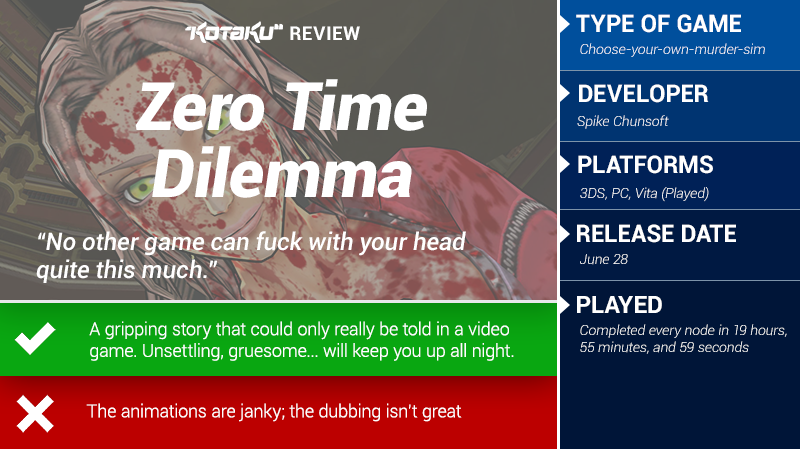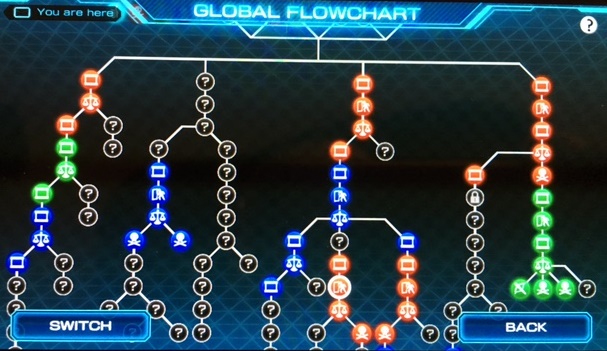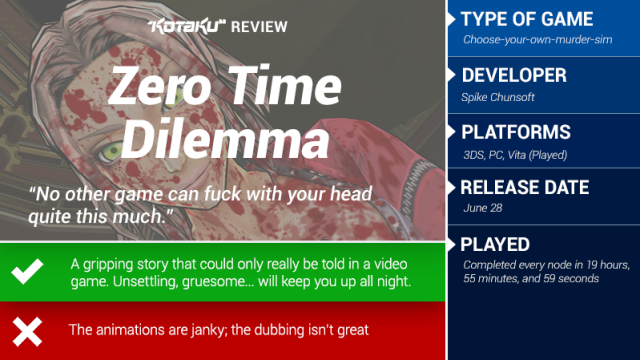There are no video games like Zero Escape. No other series plays with the interactive form to tell stories in such an elaborate, satisfying way. No other game can fuck with your head quite this much. Nothing else even comes close.
Zero Time Dilemma, the third game in the series, is no exception. Longtime fans may have raised an eyebrow when they found out that it ditches the heavy text of its predecessors for a more cinematic approach, but not to worry: Zero Time Dilemma is just as unsettling and intricate as you’d hope. Like 999 and Virtue’s Last Reward before it, ZTD is full of subversive twists, mind-boggling plots and debates over quantum mechanics.
Director Kotaro Uchikoshi and his team have again created something spectacular.

You shouldn’t play Zero Time Dilemma before playing the first two games, but if you’re thinking about it regardless, here are the basics: ZTD, like its predecessors, places nine people into a deadly game run by a masked psychopath who calls himself Zero. They’re all trapped in a bunker and told that in this particular game there’s only one rule: When six people die, the other three can leave.
Of course, simply murdering one other isn’t a feasible option for this group of characters, which includes Sigma, Phi, Akane and Junpei from previous games as well as five newcomers. They’re divided into three teams, all separated in different wings of the bunker. Early in the game, they’re told they each have to pick a team to execute, and that whichever team gets two votes will be immediately killed. Then, the fun begins.
Zero Time Dilemma‘s story is told through little vignettes called fragments, each of which typically contains a few cinematic scenes, a puzzle room and a major decision. One fragment, for example, shows Sigma, Phi and the newcomer Diana in an incinerator room. Phi is trapped in the incinerator, and the three of them have to work together to solve a series of puzzles that will allow her to escape. Once they finish, however, Sigma finds himself trapped in shackles, a revolver pointed at his head. Zero pops up and explains: The incinerator door will only open if Diana pulls the trigger. Three of the revolver’s barrels are loaded; three are empty. If Diana doesn’t fire, Phi will die. If she does fire, there’s a 50/50 chance that Sigma will die. Your call.
You can play through these fragments in pretty much any order, which is kind of unsettling but makes perfect narrative sense, because at the end of each segment, everyone is put to sleep and told that their memories will be erased. In fact, you won’t actually know where each fragment fits in the timeline until you’ve finished it. Once you’ve reached a fragment’s ending, you’ll see it fall into place on the big chronological flowchart, which can be helpful both as a reference and to see which branches you still have left to go through:

It’s a smart system, and part of what’s fun about navigating Zero Time Dilemma‘s story is trying to fit all these pieces together. Oh, so now we’re in the timeline where [REDACTED] dies. But wait, [REDACTED] is dead too. Then how the hell did [REDACTED] get murdered? As you play and replay each section, you’ll have to keep track of all the variables. You’ll probably want to take notes. You’ll definitely need to remember some passwords.
Your time with this game will be spent: A) watching cinematics play out; B) solving escape-the-room puzzles; and C) making tough decisions. You’ll also be retracing your steps in order to see alternative outcomes to those decisions. (Tip: If you’re ever at a point where you can’t access any new scenes, go back and see if there are any outcomes you haven’t explored yet.)
Previous games in the series relied on lengthy text passages to describe the action and dialogue between puzzles, but Zero Time Dilemma instead features fully voiced cutscenes. The decision to pivot to cinematic storytelling is an interesting one, apparently made to draw more players into the series. In some ways it works: The writing is stellar (props to the localisation team), the camera-work is very interesting and it’s all generally well-directed. In other ways, it’s a bust. The animations are stiff and unpleasant, clearly made by a small team with a limited budget. The dubbing isn’t great, either, with the exception of Zero, whose Bane-like monologues are a consistent highlight throughout the game. A lowlight: Mira, a misplaced new character whose narrative arc never actually gets much resolution and whose cleavage-centric apparel is more preposterous than sexy.

Still, these cinematic scenes maintain the urgent, mysterious energy I’ve come to expect from a Zero Escape game. Sometimes they’re funny; other times they’re twisted. Often the game will seamlessly bounce between gruesome deaths and sexual innuendo. Uchikoshi’s penchant for random digressions about scientific minutia and heavy-handed philosophy is on full display here. It’s fantastic.
One puzzle left me stuck for a while because of a poor translation. When you see the words “From the far left” in a file, know that what it really means is “Starting with the far left”. Other than that, the puzzles are generally excellent, just as good if not better than the escape rooms of Virtue’s Last Reward. They’re challenging but never feel unfair, and take more creative risks than previous games. A bonus: This time around, you can safely read the in-game story files — unlocked after each event — without seeing spoilers for events that haven’t happened yet.
At the beginning of Zero Time Dilemma, you’re treated to a story about a woman. She was jogging in a park and reached a fork in the road. Usually she went right, but on this particular day, she jogged left, because she saw a snail on the right side of the road. Shortly afterwards, she was murdered. “If that snail hadn’t been on the right path 17 years ago, what would have happened?” asks Zero. “Life is simply unfair, don’t you think?”
In Zero Time Dilemma, you’re the snail. Play it and you’ll understand.

Comments
9 responses to “Zero Time Dilemma: The Kotaku Review”
Oh my goodness I hope someone from the AU team does the tried and true ‘I picked up a game I had no idea about and look where it got me’ with this, or at the very least one of its predecessors.
Spoilsy spoilsy:
999 was my favourite game in the world for a long time. VLR less so, but I get that it was all leading up to this. Are there any decent re-caps of VLR/where everybody who is important to the story ended up? I’ve read a smattering of reviews and thoughts on ZTD, I kinda want to follow the new characters a bit rather than the Junpei/Akane or Sigma/Phi teams.I still can’t understand how Akane/Zero was able to be Zero in the first place considering she died as a child during the first game. Or was this explained with the in-game logic?All I say is, these games are a better representation of the plot and themes in Bioshock Infinite, than what was found in Bioshock Infinite. I played them all around the same time, and holy hell did I end up enjoying 999/VLR more.
You mean how Akane survived in 999? Pretty sure the ending already showed how Akane survived the first nonary game because Junpei saved her in the second nonary game which the second nonary game was done by Akane to awaken Junpei’s power to save her child self in the first nonary game because she remember that Junpei was the one that saved her.Unless we are talking about the different thing?
The answer to your second question was actually answered by the creator ages ago. IIRC it went along the lines of:
Akane is basically a Schrödinger’s Cat in that 9 years before the game she:1. Died alone
2. Died after contacting Junpei but didn’t solve the problem
3. Survived after communicating with Junpei
Due to the immense psychic energy surrounding this event, it leaves Akane in a state of flux as in the same timeline she is both dead and alive. The only way to remedy the situation is to recreate the events she saw in that future vision.
Thanks people.
I need a lie down.
I’m so pumped for this.
Pumped enough that I spent most of my limited free time the last month replaying the first two.
Pumped enough that I set aside the weekend to finishing in time.
Pumped enough that, even though forgot about and thus fell foul of the PEC chamber glitch in VLR which corrupted my save file 19 hours in, I started from the start again because that game was worth it.
Pumped enough that I took a day of annual leave on Monday to make sure I could finish my replay in time.
I’ve only got an hour or so left and it’s now lunch time. This is going to be a great and messed up next few weeks.
So does anyone know where I can grab a copy of 999 so I can get into the series? Looking around online today didn’t too me too much good. Also, would the North American version work on my Australian 3DS?
Yup! DS games aren’t region locked – but 3DS games are. I got my copy of 999 from ozgameshop, although I think they’re out of stock now :s
edit: yup, they’re out of stock, sorry. Also, for the record, DSi games are region locked, regular DS isn’t. Just thought I should say that.
Is this game available on the eshop or PSN as yet?
It’s on PSN right now and theoretically it will be out on the eShop tomorrow.
It’s out on eShop now!